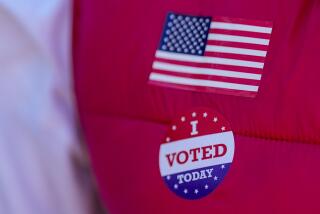Analysis: In New Hampshire, candidates tread through old towns and new political turf
The New Hampshire presidential primary, into which millions of dollars and campaign hours have been dumped, will play Tuesday on different political turf than was trod by candidates in the past.
Broad changes to the state’s population — and that new population’s political views — have made New Hampshire more willing to embrace the insurgent Democratic candidacy of Sen. Bernie Sanders and, potentially, that of Sen. Marco Rubio, if his debate performance over the weekend hasn’t damaged him in the minds of Republican voters.
The stereotypical New Hampshire Republican voter, a rugged, self-sufficient type fixated on limiting taxes, has given way to one living in the southern, Massachusetts-adjacent suburbs, particularly Hillsborough and Rockingham counties. The Democratic Party, once buttressed by mill workers in eastern and central towns, has expanded its reach all over the state, but particularly in those same southern counties and along the western edge of the state, near Vermont.
TRAIL GUIDE: All the latest news on the 2016 presidential campaign >>
Suburbs and exurbs that had spotted the countryside now form unbroken furrows across the southern part of the state; the old mills of Manchester and other towns now house tech firms and universities.
Pushing the change have been the tidal surges that reshape politics in many places: Older residents, mostly conservative, are dying off; younger and more liberal residents have moved in. The state’s attractions, including a midsection plump with lakes, have lured migrants who have brought moderating political views with them.
New Hampshire remains overwhelmingly white; African American or Latino residents are rare attendees at political events. But the white population is different than it was, demographers and political analysts say. Only 45% of New Hampshire residents were born here, a lower percentage than in all but five states.
“This population has a much broader range of experience,” said Kenneth M. Johnson, senior demographer at the Carsey Institute at the University of New Hampshire. “It’s not a parochial state.”
This year, the changes have worked to the benefit of Sanders, the senator from neighboring Vermont. That is because many of the new voters share his views and many are very aware of him: One of the growing Democratic areas, the Connecticut River Valley on the state’s western edge, abuts the state he represents, and a significant share of the residents work there. His self-described revolutionary campaign is well positioned to accomplish what no other Democratic challenger here has in decades: a victory.
Sanders’ strength among moderate, working-class Democrats here robs Clinton of a group she benefited from when she defeated then-Sen. Barack Obama in 2008. Her husband, Bill Clinton, commanded those voters in his 1992 second-place finish, during which he dubbed himself the “comeback kid.”
“Sanders has advantages, not just geographically and ideologically,” said Dante Scala, a University of New Hampshire political scientist. “Hillary Clinton, whose husband was the comeback kid because of those white working class voters — Clinton may lose them and lose them handily to the most progressive senator in America, which would be remarkable.”
The demographic churn hurts Clinton as well. About 30% of New Hampshire voters either weren’t old enough to vote in 2008 or didn’t live in New Hampshire then, which means 30% of the voters have no fond recollection of her victory here.
To escape without a horrible thumping, Clinton is banking on the support of suburban mothers and older women, particularly in the populous south, where she has spent most of her time campaigning. It is those women who rescued Clinton in 2008.
A focus of her argument to many women has been gun control. In debates and at events, Clinton has criticized Sanders extensively for his votes to benefit gun owners and gun sellers. Mailers attesting to his position have fluttered through the southern reaches of New Hampshire, and Clinton has campaigned there with former congresswoman and gun control advocate Gabrielle Giffords, who was grievously wounded in an attempted assassination in 2011.
Whether there are enough women out there to turn things around for her is questionable.
“Right now, I don’t think there are enough of them that she could switch to win it,” said UNH pollster Andrew Smith. “But she could get this down to single digits.”
Demographics are cutting another way in the Republican race. Iowa caucus winner Sen. Ted Cruz, a favorite of religious conservatives, has found it difficult to get footing in a state with a small proportion of those voters. Only about 1 in 5 Republican voters in past primaries were religious conservatives, less than half the percentage in Iowa.
“The social conservative candidates who do well in Iowa don’t do well here,” Smith said.
Donald Trump has consistently led in state polls.
If the Democratic race has divided by age, the Republican one has been cut by class and complicated by a high level of indecision. Trump’s voters should be primarily the conservative working-class residents of places like Strafford County, on the east side of the state. Some of the county is liberal — the university is located there — but to the north are areas where the tea party has been strong.
Rubio, on the other hand, seems tailor-made for the suburbs, particularly in the southern counties.
“If Donald Trump is going to do well, he’s going to do well in more conservative, working-class areas like Rochester and Somersworth” near the Maine border, Scala said.
“If Marco Rubio does unexpectedly well Tuesday, I think that’s going to be thanks to suburban, college-educated, somewhat conservative Republicans living in Hillsborough County and Rockingham County who at the last minute defected from Donald Trump.”
Republicans campaigning here have talked about making New Hampshire a contested state in the general election. But despite the presence on the ballot of two favorites of primary voters here, 2012 nominee Mitt Romney and 2008 nominee John McCain, Democrats carried the state both times. Republican victories are far more likely in non-presidential years like 2010, when Republican Kelly Ayotte won a Senate seat.
But the state’s once-inevitable march toward solid blue has been stopped by the effects of the Great Recession, which also caused a lot of the economic worry that has propelled Sanders among Democrats and Trump among Republicans. Migration rates slowed. If they rise again, the state could find itself with yet another a new political identity.
New Hampshire has just 1.3 million people, demographer Johnson noted: “It doesn’t take much.”
For political news and analysis, follow me on Twitter: @cathleendecker . For more on politics, go to latimes.com/decker.
ALSO
Coverage from the campaign trail
Why young feminists are choosing Bernie Sanders over Hillary Clinton
Sanders fires up New Hampshire voters and Clinton heads to Flint, Mich.
As New Hampshire primary nears, nasty campaign ads portray a battle for the country’s soul
More to Read
Get the L.A. Times Politics newsletter
Deeply reported insights into legislation, politics and policy from Sacramento, Washington and beyond. In your inbox three times per week.
You may occasionally receive promotional content from the Los Angeles Times.







